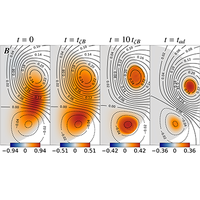
Physical Review D
@PhysRevD
Followers
9K
Following
21
Media
35
Statuses
885
@APSPhysics journal covering elementary particle physics, field theory, gravitation & cosmology.
College Park, MD
Joined December 2015
A recent Suggestion considers an extreme mass ratio black hole inspiral within a scalar cloud. The inspiral induces radiation from the cloud, which in turn can modify the dynamics of the orbit, causing shifts in the gravitational wave pattern. #EdSugg
https://t.co/a6RrmUXIa2
journals.aps.org
Extreme-mass-ratio binaries are important sources of gravitational waves (GW) for space-based GW detectors such as LISA. Employing the newly developed modified Teukolsky formalism, the present paper...
0
0
5
A new Suggestion extends previous work on loop computations using recursion relations from "cut equations". By carefully defining planar loop integrands, the authors generalize this technique to gluons in pure Yang-Mills theory. #EdSugg
https://t.co/86WNQ7yWdd
journals.aps.org
Calculating higher-loop scattering amplitudes in pure Yang-Mills theory is a long-standing challenge. By using a novel geometric framework for scattering amplitudes, the authors develop a recursive...
0
0
2
While black hole entropy is often studied via its relationship to the area of the event horizon, this highlight proposes an upper bound on entropy from the BH's specific heat. This can be proved for special conditions and tested in other examples. #EdSugg
https://t.co/BXKb10iehy
journals.aps.org
Black holes aren't just cold graves of gravity -- they have temperature and entropy. Previous studies have emphasized black holes' role as the most entropic objects in the universe, that the entropy...
1
1
4
Primordial black holes may form in the early universe. For masses < 10⁹ g they are thought to evaporate without a trace before nucleosynthesis. But, a new Suggestion shows such objects can cluster and merge, potentially leaving detectable signals. #EdSugg
https://t.co/TJqRp8YQlx
journals.aps.org
Light Primordial Black Holes (PBH) can dominate the universe before the onset of the radiation epoch and may evaporate prior to Big Bang Nucleosynthesis (BBN). The authors show that if this PBH-dom...
0
0
2
Measurements of cosmic distances suggest the dark energy in our universe may be changing over time. However, a recent highlight finds that relaxing the assumption of a perfectly isotropic universe via a local overdensity can also fit the data. #EdSugg
https://t.co/FSupW0KkRS
journals.aps.org
The authors use the latest Baryon Acoustic Oscillation (BAO)- and supernova-based distance data to extend \ensuremath{\Lambda}CDM, demonstrating that local cosmological overdensities can provide an...
0
2
6
This Suggestion explores a new source of gravitational waves during first order phase transitions in the early universe. Colliding bubbles can efficiently produce particles coupled to the field undergoing the transition, impacting the GW signal. #EdSugg
https://t.co/2mX4bJyPD8
journals.aps.org
In this paper, the authors discuss a new source of gravitational waves from first order phase transitions. The collision of bubbles in the new phase can efficiently produce particles that couple to...
0
0
2
The high luminosity of magnetars is thought to be powered by decay of their extreme magnetic fields. However, in this highlight detailed simulations of stellar evolution with heating from ambipolar diffusion show this mechanism may not be enough. #EdSugg
https://t.co/mZMXDteSDK
journals.aps.org
Magnetars are neutron stars with extremely strong magnetic fields; typically they are about 1000x stronger than the ``garden variety'' radio pulsars. They are also extremely hot and bright and it is...
1
1
5
Ultracompact objects may collapse due to nonlinear instabilities related to stable light rings. In this Suggestion detailed numerical simulations are used to show that scalarized Reissner-Nordström black holes can remain stable despite such rings. #EdSugg
https://t.co/5v8pl26eC2
journals.aps.org
Ultracompact objects have been recently found to be susceptible to a new nonlinear instability known as light-ring instability, triggered by stable light rings, thereby raising concerns about the...
0
2
3
The time between the end of inflation and the onset of nucleosynthesis is poorly understood. A recent highlight examines the case of matter domination in this era, where self-interactions can lead to primordial black holes and other exotic objects. #EdSugg
https://t.co/FEb3Q6WpnQ
journals.aps.org
Cosmic history between inflation and Big Bang nucleosynthesis remains largely unconstrained. The authors explore a novel scenario in which self-interacting particles driving early matter domination...
0
5
10
Inspiralling neutron stars undergo tidal deformation, which leaves an imprint in gravitational waves. A new Suggestion applies a general relativistic approach to the nonlinear regime where tidal and internal hydrodynamical timescales are similar. #EdSugg
https://t.co/Hg3RUIzZzN
journals.aps.org
Tidal deformations of neutron stars in binary inspiral leave an imprint on gravitational-wave emissions. Dynamical tides -- in which the timescales of the tidal field and the internal hydrodynamics...
0
1
4
A recent highlight uses effective field theory to study the effects of spinning particle models of Kerr black holes, pushing forward the gravitational self-force expansion. and identifying a new spinning recoil term. #EdSugg
https://t.co/DaTKwMQq2L
journals.aps.org
The gravitational self-force approach to the two-body problem is experiencing rapid development. This paper reports on incorporating spin into the effective field theory approach to gravitational...
2
1
7
Future gravitational wave detectors will have better sensitivity and cover wider frequency bands than current experiments, bringing new complications. A recent highlight examines methods for disentangling overlapping signals from multiple events. #EdSugg
https://t.co/ywFozwfTBc
journals.aps.org
The problem of overlapping signals in gravitational wave astronomy refers to situations where signals from distinct events overlap in time. They pose a challenge for distinguishing the sources of the...
0
3
4
See here for a Focus story on their award-winning work, including free-to-read papers published in the Physical Review. #physics
https://t.co/L4SAsIsqzn
physics.aps.org
The 2025 Nobel Prize in Physics recognizes the discovery of macroscopic quantum tunneling in electrical circuits.
0
0
3
We're celebrating this year's Nobel Prize winners in physics! Congratulations to APS members John Clarke, Michel H. Devoret, and John M. Martinis for their work on macroscopic quantum devices and tunneling. #physics
https://t.co/KkKY0gwhjF.
aps.org
The American Physical Society is a nonprofit membership organization working to advance physics by fostering a vibrant, inclusive, and global community dedicated to science and society.
0
0
1
The DESI papers from the Data Release 2 have now been published in Physical Review D. Visit https://t.co/4ePWrToG66 to see the special issue compiled by the Physical Review Astronomy and Astrophysics Topical Group, which is expanding its coverage of astronomy and astrophysics.
0
2
5
Cooling white dwarfs go through a phase of periodic luminosity fluctuations. Data from the Kepler telescope also shows aperiodic and semi-periodic flares. A new Suggestion shows how tools from statistical physics can be used to model this behavior. #EdSugg
https://t.co/Cu8TWN7Jh5
journals.aps.org
As white dwarfs cool, they move into a regime in parameter space where they experience brightness fluctuations on a semi-periodic basis. Recently, Kepler has revealed that these white dwarfs also...
0
1
0
This highlight examines baryonic feedback effects on cosmological observables. Using a halo assembly histories approach, the authors study feedback on Sunyaev-Zel��dovich effects, X-ray counts and weak lensing as functions of halo mass and redshift. #EdSugg
https://t.co/gnUpGTCgWL
journals.aps.org
Understanding the impact of baryonic feedback on cosmological observables remains a pivotal challenge in precision cosmology. Using FLAMINGO simulations, the authors explore how feedback influences...
0
3
0
A new Suggestion presents state-of-the-art lattice QCD calculations of the semileptonic decay of 𝐷𝑠 mesons. Taking into account all systematic errors the authors find good agreement with experiment, with a clear potential for improvement. #EdSugg
https://t.co/WYpwlTnIST
journals.aps.org
Standard model prediction for the semileptonic decay of Ds meson using state-of-the-art lattice QCD calculation agrees well the experimental determinations.
0
3
2
🎉 Congratulations to the 2025 Reviewer Excellence Award winners: https://t.co/KlMTZOVDni Their commitment to rigorous, constructive peer review helps maintain the integrity and quality of the Physical Review journals. #PeerReviewWeek
0
23
20
Feynman diagrams for particle scattering are not manifestly causal, involving intricate cancellations to arrive at a physical result. A new Suggestion tries to improve this by implicitly summing over final states in a probability-level approach. #EdSugg
https://t.co/T9eGognmfL
journals.aps.org
Though ubiquitous in modern perturbative calculations in quantum field theory, Feynman diagrams for scattering amplitudes do not make the property of causality, that no signal can travel faster than...
0
1
6
















